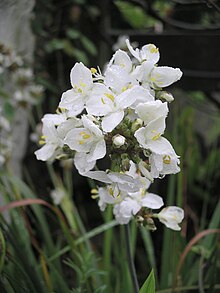| Libertia | |
|---|---|

| |
| Libertia chilensis | |
| Scientific classification | |
| Kingdom: | Plantae |
| Clade: | Tracheophytes |
| Clade: | Angiosperms |
| Clade: | Monocots |
| Order: | Asparagales |
| Family: | Iridaceae |
| Subfamily: | Iridoideae |
| Tribe: | Sisyrinchieae |
| Genus: | Libertia Spreng. 1824, conserved name not Dumort. 1822 (syn of Hosta) nor Lej. 1825 (syn of Bromus) |
| Type species | |
| Libertia ixioides | |
| Synonyms[1] | |
| |

Libertia is a genus of monocotyledonous plants in the family Iridaceae, first described as a genus in 1824.[2] It is native to South America, Australia, New Guinea, and New Zealand. Eight species are endemic to New Zealand.[1][3][4]
Libertia is made up of herbaceous or evergreen perennials growing from short rhizomes,[2] with simple, linear or narrowly lanceolate basal leaves which are often green but may be red, orange, or yellow under direct sunlight.[5] The showy white or blue trimerous flowers are open in spring and are followed by capsules opening by three valves which contain the numerous seeds.[6]
The genus was named after the Belgian botanist Marie-Anne Libert[7] (1782–1865) (also referred to as Anne-Marie Libert).[8]
The species Libertia chilensis has gained the Royal Horticultural Society's Award of Garden Merit.[9][10]
- Species[1]
- Libertia chilensis (Molina) Gunckel - central + southern Chile, southern Argentina, Juan Fernández Islands
- Libertia colombiana R.C.Foster - Colombia, Ecuador, Peru, Bolivia
- Libertia cranwelliae Blanchon, B.G.Murray & Braggins - North Island of New Zealand[3]
- Libertia edgariae Blanchon, B.G.Murray & Braggins - North Island of New Zealand[3]
- Libertia falcata Ravenna - Los Lagos region of Chile
- Libertia flaccidifolia Blanchon & J.S.Weaver - North Island of New Zealand
- Libertia grandiflora (R.Br.) Sweet - North + South Islands of New Zealand
- Libertia insignis Ravenna - Los Lagos region of Chile
- Libertia ixioides (G.Forst.) Spreng. - North + South Islands of New Zealand
- Libertia micrantha A.Cunn. - North + South Islands of New Zealand
- Libertia mooreae Blanchon, B.G.Murray & Braggins - North + South Islands of New Zealand[3]
- Libertia paniculata (R.Br.) Spreng. - eastern Australia[11] - Branching Grass Flag
- Libertia peregrinans Cockayne & Allan - North + South + Chatham Islands of New Zealand
- Libertia pulchella (R.Br.) Spreng. - New South Wales, Victoria, Tasmania, North + South Islands of New Zealand, New Guinea[4][12]
- Libertia sessiliflora (Poepp.) Skottsb. - central Chile
- Libertia tricocca Phil. - central + southern Chile
- Libertia umbellata Ravenna - Los Lagos region of Chile
- Selected formerly included[1]
Numerous names have been coined using the name Libertia, referring to species that are now regarded as better suited to other genera (Bromus Cardiocrinum Hosta Orthrosanthus).
- Libertia arduennensis - Bromus bromoideus
- Libertia arundinacea - Bromus bromoideus
- Libertia azurea - Orthrosanthus multiflorus
- Libertia cernua - Hosta plantaginea
- Libertia graminea - Orthrosanthus laxus var. gramineus
- Libertia heteroclita - Cardiocrinum cordatum
- Libertia laxa - Orthrosanthus laxus
- Libertia recta - Hosta ventricosa
- Libertia stricta - Orthrosanthus multiflorus
- ^ a b c d Kew World Checklist of Selected Plant Families
- ^ a b Sprengel, Curt Polycarp Joachim 1824. Systema Vegetabilium, editio decima sexta 1: 127 in Latin
- ^ a b c d Blanchon, D.J.; et al. (2002). "A taxonomic revision of Libertia (Iridaceae) in New Zealand". New Zealand Journal of Botany. 40 (3): 437–456. Bibcode:2002NZJB...40..437B. doi:10.1080/0028825x.2002.9512805. S2CID 83634447.
- ^ a b "Census of vascular plants of Papua New Guinea". Retrieved 2010-01-01.
- ^ "Stephen Butler | IGPS Blog". igpsblogs.wordpress.com. Retrieved 2017-03-12.
- ^ Goldblatt; Henrich; Keating, Peter; James; Richard (1989). "Seed morphology of Sisyrinchium (Iridaceae-Sisyrinchieae) and its allies". Annals of the Missouri Botanical Garden. 76 (4): 1109–1117. doi:10.2307/2399695. JSTOR 2399695.
{{cite journal}}: CS1 maint: multiple names: authors list (link) - ^ Quattrocchi, Umberto (2006). CRC World Dictionary of Grasses, Common Names, Scientific Names, Eponyms, Synonyms, and Etymology. Vol. 1. Taylor and Francis. p. 124. ISBN 9781420003222.
- ^ Manning, John; Goldblatt, Peter (2008). The Iris Family: Natural History & Classification. Portland, Oregon: Timber Press. pp. 215–16. ISBN 978-0-88192-897-6.
- ^ "RHS Plantfinder - Libertia chilensis". Retrieved 22 March 2018.
- ^ "AGM Plants - Ornamental" (PDF). Royal Horticultural Society. July 2017. p. 60. Retrieved 14 March 2018.
- ^ "Libertia paniculata". Australian Plant Name Index (APNI), IBIS database. Centre for Plant Biodiversity Research, Australian Government.
- ^ "Libertia pulchella". Australian Plant Name Index (APNI), IBIS database. Centre for Plant Biodiversity Research, Australian Government.